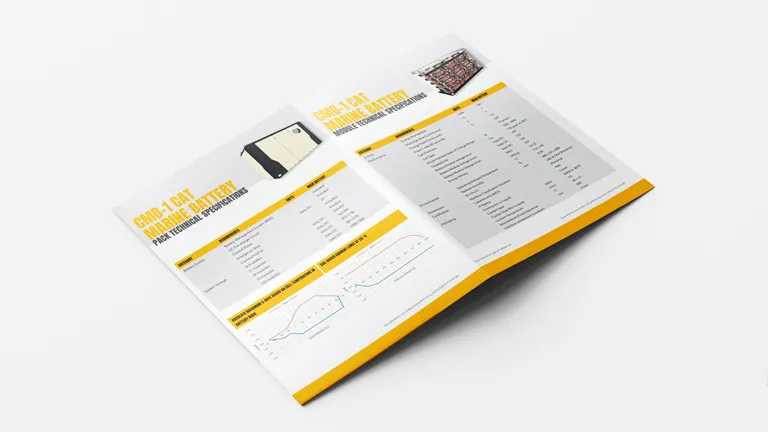Maritime battery systems enable quieter and cleaner operations at sea. They help reduce fuel consumption, lower CO₂ and NOₓ emissions, and improve comfort and working conditions for crew and passengers.

Caterpillar
Maritime Batteries
Modern shipping requires safe, flexible, and scalable energy solutions. Caterpillar delivers maritime battery systems specifically developed for the demanding conditions at sea. With a focus on performance, safety, and international certification, these systems provide a future-proof solution for a wide range of applications.
- High-quality
- Modular
- Global service
Cat CMB-1 maritime battery
The Caterpillar CMB-1 maritime battery system represents innovation, reliability, and safety in maritime energy storage. Specifically designed for the demanding conditions at sea, this system combines flexibility, scalability, and advanced safety technologies. With international certifications, efficient cooling systems, and seamless integration capabilities, the Cat CMB-1 offers a future-proof solution for a wide range of maritime applications.

Specifications
With multiple installation options and support for various DC voltage levels, the Cat CMB-1 offers flexibility and scalability for seamless integration across a wide range of platforms.
Per module:
- Nominal voltage: 125 VDC
- Energy: 28.5 kWh
- Dimensions: 251 x 588 x 888 mm
- Weight: 220 kg
Why choose our maritime battery?
Safety
Safety comes first: LFP cells, thermal protection, and the Cat Battery Management System continuously monitor the temperatures of cells and modules. In case of deviations, the system automatically intervenes to ensure maximum operational reliability.
Performance & integration
Flexible and scalable battery systems that easily fit a variety of maritime platforms. Supports a wide voltage range, simple network integration via Ethernet RJ45, and is internationally certified (ABS, DNV) for maximum reliability and safety.
Cooling & monitoring
The liquid cooling system keeps modules and cells at optimal temperatures. Thanks to IP65 protection and leak detection, the batteries continue to operate safely and reliably even under harsh conditions.
How can we help you?
Looking for more information about our maritime battery systems? Get in touch with us today.
Frequently Asked Questions about Maritime Battery Systems
Inland vessels, ferries, offshore vessels, tugs, and yachts can all benefit from maritime battery systems. For larger ships, a hybrid solution is often the most suitable.
Contact us to discuss your specific requirements.
Modern maritime battery systems comply with strict maritime safety standards. They feature advanced cooling, monitoring, and protection systems against overheating or short circuits. They are MCS-classified according to standards such as DNV and ABS.
Depending on the application, specific usage, and number of charge cycles, the service life is typically around 10 years. Proper management and maintenance can significantly extend the lifespan.
Yes, hybrid systems combine diesel engines with batteries. This reduces fuel consumption and emissions without compromising flexibility or range. Hybrid variants, such as parallel or series hybrids, can be effectively optimized through the Energy Management System, integrating the generator sets or diesel engine with the Pon Power CMB-1 battery system.
Charging time depends on battery capacity and the available charging infrastructure. With current charging facilities, this can be achieved in as little as one hour. No charging infrastructure? Experiencing grid congestion? We are your partner in finding effective solutions.
Using batteries can reduce fuel consumption by 30–80%, depending on the type of vessel and its routes. This allows for more efficient use of the combustion engines, resulting in a significant reduction in emissions.
Yes, our maritime battery systems can be recycled. We collaborate with specialized partners to facilitate and manage the recycling process.
Because batteries are continuously monitored, frequent maintenance is not required. Maintenance and technical oversight are primarily related to the integration with software systems, including the Battery Management System, Vessel Management, and further integration with other ship systems.
Yes, both national and European-level subsidies and programs exist to promote the decarbonization of shipping. Stricter emission regulations also contribute to the growing demand for battery solutions.
Battery systems are modular and therefore scalable. For longer distances, a combination of batteries and alternative fuels, such as hydrogen, is often employed.
